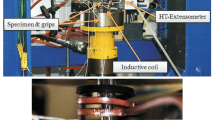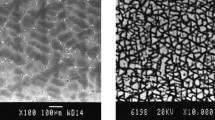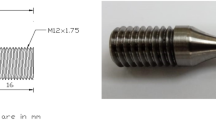Abstract
TiAl is supposed to substitute Ni or Ti alloys in energy conversion systems, such as aero engines. These components are subjected to thermomechanical fatigue (TMF), whereas this mechanical behaviour may substantially differ from isothermal low cycle fatigue (LCF). Therefore, it is necessary to assess TMF properties, in order to establish a reliable and precise lifetime prediction model. In this study the γ-base TiAl intermetallic alloy TNB-V2 was subjected to fully-reversed TMF tests under total strain control at strain amplitude of 0.7%, accompanied by LCF tests in air and vacuum. Temperature ranged from 550°C to 850°C. In TMF tests a continuous built-up of compressive (in-phase) or tensile (out-of-phase) mean stresses is observed. The lifetime ratio between IP and OP is 30–200, depending on temperature range. Substantially longer lifetimes of OP-TMF tests in vacuum are observed. Fracture always occurs in a transcrystalline mode. A lifetime description at 550°C based on the Basquin-Coffin-Manson equation reveals that the fatigue behaviour is governed by the amount of elastic strain even at low cycles, and the transition lifetime was found to be at 5 cycles. A damage parameter based on the equation of Smith, Watson and Topper is able to describe LCF and in-phase TMF lifetimes reasonably.












Similar content being viewed by others
References
Appel F, Lorenz U, Paul JDH, Oehring M (1999) The mechanical properties of niobium alloyed gamma titanium aluminides. In: Kim Y-W, Dimiduk DM, Loretto MH (eds) Gamma titanium aluminides 1999. TMS, Warrendale, pp 381–388
Roth M, Biermann H (2008) Thermo-mechanical fatigue behaviour of a modern γ-TiAl alloy. Int J of Fatigue 30:352–356. doi:10.1016/j.ijfatigue.2007.01.049
Bauer V, Christ H-J (2009) Thermomechanical fatigue behaviour of a third generation TiAl intermetallic alloy. Intermetallics 17:370–377. doi:10.1016/j.intermet.2008.11.013
Brookes SP, Kühn HJ, Skrotzki B, Sievert R, Pfetzing J, Eggeler G (2007) Axial-torsional thermo-mechanical fatigue of Ti-45Al-5Nb-0.2B-0.2C. In: Niinomi M, Akiyama S, Hagiwara M, Ikeda M, Maruyama K (eds) Ti-2007 science and technology, vol. 1. The Japan Institute of Metals, Sendai, pp 679–682
Christ H-J (2007) Effect of environment on thermomechanical fatigue life. Mat Sci Eng A 468–470:98–108. doi:10.1016/j.msea.2006.08.132
Appel F, Wagner R (1998) Microstructure and deformation of two-phase γ-titanium aluminides. Mat Sci Eng R 22:187–268
Sastry SML, Lipsitt HA (1977) Fatigue deformation of TiAl alloys. Met Trans A 8:299–308
Christ HJ, Fischer FOR, Maier HJ (2001) High-temperature fatigue behavior of a near-γ titanium aluminide alloy under isothermal and thermo-mechanical conditions. Mat Sci Eng A 319–321:625–630. doi:10.1016/S0921-5093(00)02013-X
Jouiad M, Gloanec A-L, Grange M, Hénaff G (2005) Cyclic deformation mechanisms in a cast gamma titanium aluminide. Mat Sci Eng A 400–401:409–412
Srivatsan TS, Soboyejo WO, Strangwood M (1995) Cyclic fatigue and fracture behavior of a gamma-titanium aluminide intermetallic. Eng Frac Mech 52:107–120
Appel F, Heckel TK, Christ H-J (2009) Electron microscope characterization of low cycle fatigue in a high-strength multiphase titanium aluminide alloy, Int J of Fatigue, doi:10.1016/j.ijfatigue.2009.04.001
Fröbel U, Appel F (2002) Strain ageing in gamma(TiAl)-based titanium aluminides due to antisite atoms. Acta Mater 50:3693–3707
Mishin Y, Herzig C (2000) Diffusion in the Ti-Al system. Acta Mater 48:589–623
Venkateswara Rao KT, Kim Y-W, Muhlstein CL, Ritchie RO (1995) Fatigue-crack growth and fracture resistance of a two-phase (γ+α2) TiAl alloy in duplex and lamellar microstructures. Mat Sci Eng A 192/193:474–482. doi:10.1016/0921-5093(94)03264-5
Nickel H, Zheng N, Elschner A, Quadakkers WJ (1995) The oxidation behaviour of niobium containing γ-TiAl intermetallics in air and argon/oxygen. Mikrochim Acta 119:23–39
Yoshihara M, Kim Y-W (2005) Oxidation behavior of gamma alloys designed for high temperature applications. Intermetallics 13:952–985. doi:10.1016/j.internet.2004.12.007
Chan KS, Kim Y-W (1991) Fracture processes in a two-phase gamma titanium aluminide alloy. In: Kim Y-W, Boyer RR (eds) Microstructure / property relationships in titanium aluminides and alloys. TMS, Warrendale, pp 179–196
Malakondaiah G, Nicholas T (1996) High-temperature low-cycle fatigue of gamma titanium aluminide alloy Ti-46Al-2Nb-2Cr. Met Mat Trans A 27:2239–2251
Park YS, Nam SW, Hwang SK, Kim NJ (2002) The effect of the applied strain range on fatigue cracking in lamellar TiAl alloy. J Alloys Compd 335:216–223. doi:10.1016/S0925-8388(01)01812-6
Hertzberg RW (1976) Deformation and fracture mechanics of engineering materials. John Wiley & Sons, New York
Hoppe R (2008) Personal communication. GKSS Research Centre, Geesthacht
Smith KN, Watson P, Topper TH (1970) A stress-strain function for the fatigue of metals. J Mater 5:767–778
Dowling NE (2007) Mechanical behavior of materials. Pearson Prentice Hall, Upper Saddle River
Acknowledgements
Financial support for this work by Deutsche Forschungsgemeinschaft (DFG) is gratefully acknowledged. The authors would also like to thank their project partner for providing the material and performing complementary investigations (Dr. F. Appel and his research group, GKSS Research Centre, Geesthacht, Germany).
Author information
Authors and Affiliations
Corresponding author
Rights and permissions
About this article
Cite this article
Heckel, T.K., Christ, HJ. Thermomechanical Fatigue of the TiAl Intermetallic Alloy TNB-V2. Exp Mech 50, 717–724 (2010). https://doi.org/10.1007/s11340-009-9264-3
Received:
Accepted:
Published:
Issue Date:
DOI: https://doi.org/10.1007/s11340-009-9264-3




